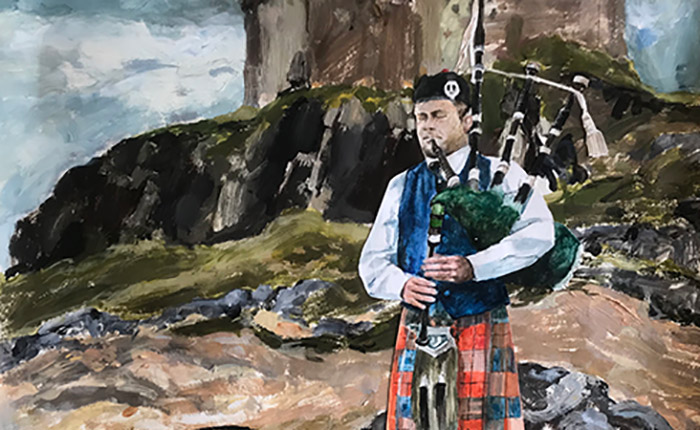
We know very little of the Rankin family from the island of Mull and mentioned in Angus MacKay’s book as hereditary pipers to the MacLean of Coll ‘from time immemorial’. The most notable was Conn Dauly and he is believed to have been instructed on Skye either by the MacCrimmons or the MacArthurs. MacKay’s book relates the tale of a Rankin playing for Dr Johnston on his tour of the Western Isles and that that Conn Dauly emigrated to Prince Edward Island in Canada. The author of this article, Calum MacLean, featured in the winning painting (above) in our lockdown challenge.
The Rankin pipers of Mull were held in great regard in their day, but they appear not to have left much information for us to go on, only some stories that survive in local tradition and a few references in piping and history books. Maybe some piobaireachd compositions too, but it is hard to say for certain which ones.
Let us have a closer look at the stories and see if we can find out what is fact and what is fiction.
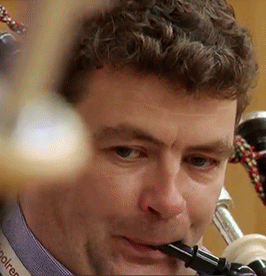
By Calum MacLean, Tobermory
This first story is set on the isle of Mull and involves an English piper from Northumberland who came to the island each year for three years, and each time he and Rankin had a competition to see who the better piper was.
Now, these competitions were probably a bit different to the ones we have today. I think they were more along the lines of last man standing; no judges bench. A competition of who had the greater knowledge of the music and a trial to see who could keep playing adding more difficult variations to the tunes as they played. Maybe this is how piobaireachd developed into what we have today?
The scene is set; Rankin on Cnoc Nam Piobairean (hillock of the pipers) and the English piper on Dun Chuaigean (fort of the splay footed), an old fort behind Kilbreanan on Mull. I walked up there, and I must say my feet were splayed by the time I got to the top. I will have earned all the cash I get for doing this investigation!
After winning the first and second time Rankin knew he might not beat the young piper a third. He was ageing and the young man was getting better each year. Not to be out done, Rankin challenged the English piper to a duel with swords. This was at Aros down next to the river of the same name.
Rankin was said to have been immensely proud, and losing to another piper would not have gone down well with him. He is also said to have been a good swordsman, so if he could not win at piping, he was going to win at sword play.
He killed the Englishman and put a cairn up to mark the grave. Fast forward a hundred plus years …… It has been said that when a new part of the road between Salen and Tobermory was built in the 1880s bones were found. Ever since then the field has been known locally as ‘Dail an t-sasunnach’ – dale of the Englishman, the only place name on Mull with reference to an Englishman in Gaelic.
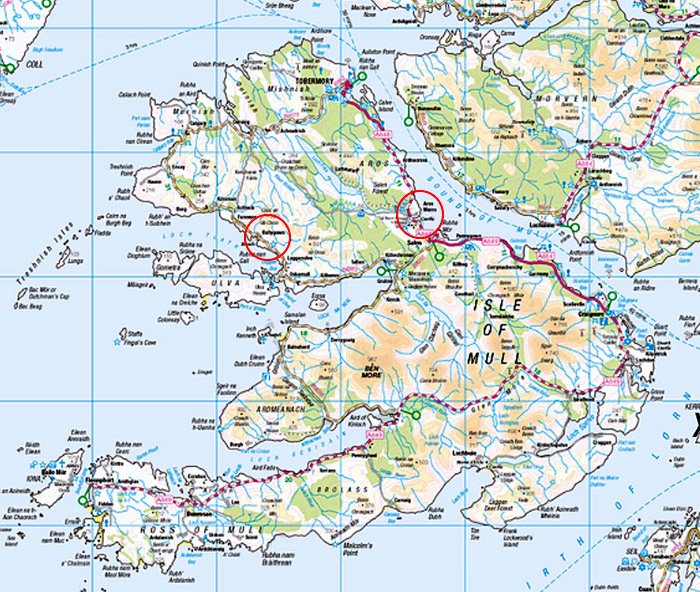
There are a few stories about the Rankin pipers, but which Rankin does this story relate to? Clandullie Rankin lived at Kilbreanan in 1716; is the story from this time or is it earlier? It is hard to say, but the Rankins do not appear to have a rent for Kilbreanan in 1679.
Sometime in the late 1600s to early 1700s the Rankins are at Kilbreanan and this could be the time when our story is set. Possibly the Rankins moved to Kilbreanan when the Macleans of Duart lost their lands to Clan Campbell in the 1690s. This would make sense, as other Maclean lairds still held lands on Mull, and Torloisk, just north of Kilbreanan, was one of them.

The story could be of a later date of course, but by 1760 the piping college at Kilbreanan was closed; so that leaves us with 1690 – 1760. Clandullie or his sons Hector and John seem to be the most likely Rankin’s involved in this story, but maybe a Ewan Rankin has a part to play?
Here are a few interesting sidelines to the Rankin college. We find in books references to the Rankins and that there was one college or school and one Rankin teaching pupils at Kilbreanan. This may have been the home of the hereditary piper to the laird, but what of his kin?
From the Disarming Act of 1716, after the first Jacobite Rising, we are lucky enough to have a list of all males on Mull of an age to hold arms. The list gives us names of more than one Rankin and where they lived. This is interesting, as all of them live in the north of Mull which is still Maclean land at this time. There are eight Rankin families living on Mull in 1716 and ten men who were old enough to have weapons.
The reason I mention this is to do with local oral tradition which ties up, in part, to our story. Aros is the place where the English piper is killed; why here and not closer to Kilbreanan?
Local tradition says that there was once a school of piping at Aros too. Could this be true? Who do we find living here in 1716? Yes, that’s right, a Rankin, Ewan of that ilk.
It is possible that more than one of the Rankins taught pipes and in different places on Mull which would explain their fame as a piping family and the number of pupils they taught. This could be why the English piper was killed at Aros where a kinsman of Conduillie Rankin lived.
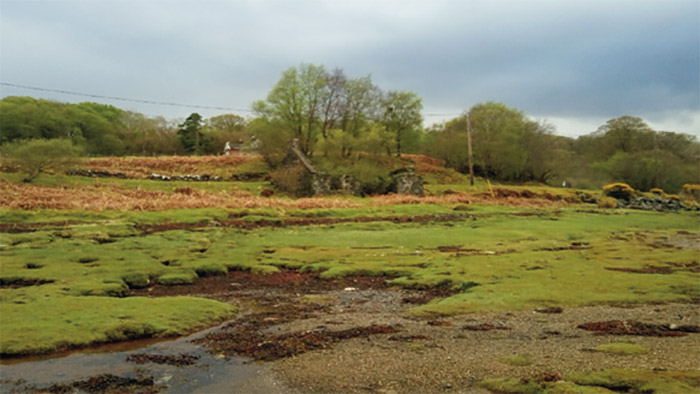
This brings us to another local legend, and it happened in the same field at Aros! On a clear summer’s night, still and quiet with the sea motionless, a Rankin piper stands on a small hill looking towards the mainland.
He plays his pipes, filling the air with the sound of a tune only known to him as he is the composer. The sound carries over the water all the way across the Sound of Mull to Morven. There a man hears the music. Being a musician, he starts to note down the tune getting what he can of it and taking it away to work out the rest of it.
Some time later the two meet at a gathering where the Morven piper plays Rankin’s tune claiming ownership. A fight ensued the outcome of which is not known.
I have not found any more information on this story but it does tie in with a piper living in the area and this is in the same field as our first story. The two stories could be linked but that is for another time with more detective work involved – but it’s too much of a coincidence for me.
Another interesting bit of local tradition about the Kilbreanan college concerns the location. It is thought that the college was in the present-day farmhouse where the Rankins lived, but it is said locally that the college was in the fort behind.
Both places are in our story Cnoc nam piobairean and Dun Chuaigean. It could be possible. I have looked at the fort and the remains have house type walls on top; often the stone of older buildings was reused for something else. But I am no expert; a job for an archaeologist.

I hope you enjoyed this wee look at couple of Rankin stories from here on my home island. What is fact and what is fiction? I will leave to you. All I can say is fact can be found in the fiction, finding it is the hard part. Join us for another tale next time where we look at a Rankin pupil and some music associated with him.
- Calum MacLean is the schools piping instructor for the island of Mull and a competing solo piper. He comes from a a musical family his late father a champion accordionist.










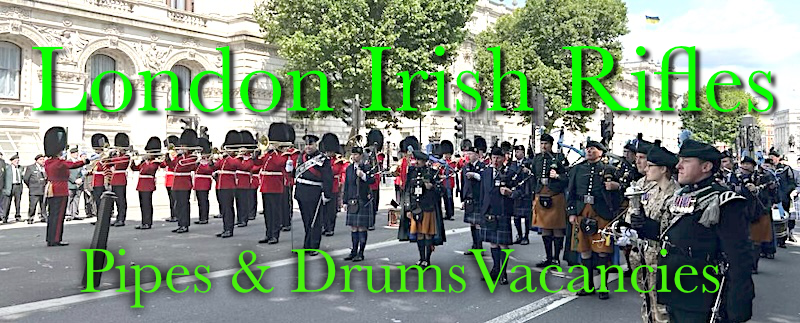


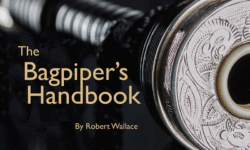
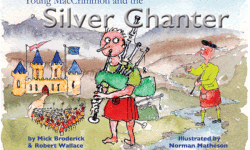





Very interesting information and delightful Rankin family stories. Researching the Internet has revealed very little empirical evidence of the Rankin sept history other than the confirming stories that they were the clan pipers for the MacLeans. I’m planning a trip to the Isle of Mull and the Highlands there to see what can be discovered!
What a great article, thank you Calum!
quoting: “From the Disarming Act of 1716… There are eight Rankin families living on Mull in 1716 and ten men who were old enough to have weapons.” Is there a link to this source material? I am trying to chase down any provable living descendants of the Mull Rankins of the early 1700s.
Whether Clandullie, or his sons Hector and John, or Ewan, or others listed there, ended up at Prince Edward Island in Canada or elsewhere, has not been proven yet in anything that I’ve found.
I am an administrator at the Rankin Y-DNA project. We have identified 8 major unrelated lines of Rankins. Four of those lines are Celtic and one may be the most likely link back to the pipers. But all of their genealogies currently hit a brick wall in the 1700’s. Anyone who has interest in this or wants to help, please visit http://www.familytreedna.com/groups/rankin and introduce yourself!
My name is Louis Taylor Rankin and I make my home in a small town in the state of Idaho, USA. I only know of the storyies my grandmother told me about having pipers from the Clan Maclean in the family. I am in my late 70s, and to this very day above my front door still hangs the coat of arms of the Clan Maclean that she passed on to me many years ago. These are proud stories and I hold them dear. Thank You.
Hello Louis. I am married to Joseph Bruce Rankin from Caldwell and we live in McCall, ID. It appears that you might live in Wendell. I have been working on both our family trees and do not see a connection to you. Just curious if you have had any connection to Rankins that came from Tennessee? This is very interesting that there may be 8 major lines or Rankins that are unrelated.
Be well,
Gail Rankin
gailrankin6@gmail.com
Glad a little more light can be shed on the Rankin name!
Interesting article. Thanks for posting.
My dad born in 1904 in Belfast n.i . I am 80 years in feb 2023.my son and grandsons hopefully will remain Rankin’s.
I read the very interesting tales. Long live the Rankin’s
Paul,
Have you tried Ancestory.com? I was amazed at their resources. Lol..Gravefinders.com also was a resource I have recently gotten familiar with, one that actually had pictures of tombstones of some military vets in my line, back to the civil war! Good hunting Paul!
Fellow Rankin, Lee.
Ok Paul!
Covid has me grounded here…I will get there!
The Rankin beat goes on !
Stay safe, healthy…keep the bloodline a flowin!
Lee
I really enjoyed reading your work as it relates to the Rankins.
I would really like to map out my family tree in hopes of finding the links back to Scotland.
I would like to travel again back to Mull and spend more time there…retracing family history.
Thanks again.
Paul, I highly encourage you to come to familytreedna.com/groups/rankin and get in touch with our site admins. We focus on helping people trace their Rankin paternal family tree through genetic genealogy.